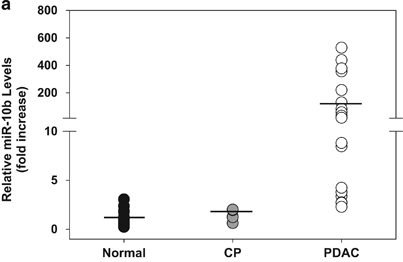Correction to: Oncogene (2014) 33, 4664-4674. doi:10.1038/onc.2013.405; published online 7 October 2013.
Since the publication of the above article, the authors noted that they had neglected to report that cel-miR-39 had been used to adjust for RNA extraction efficiency, and that only 10 normal samples and 17 pancreatic cancer samples were used to carry out the calculations.
Provided below is the revised Figure 1a and a revised figure legend to rectify these issues.
Figure 1.

(a) Plasma miR-10b levels. Compared with plasma from normal controls (n=18; closed circles) and chronic pancreatitis patients (CP; n=5; gray circles), miR-10b levels were significantly elevated (P=0.002 and P=0.067, respectively) in the plasma of PDAC patients (n=18; open circles). Horizontal bars denote mean levels. For each sample, 3 μl of a 5 nM cel-miR-39 oligonucleotide stock were added to 100 μl of plasma. RNA was then isolated with TRIzol LS Reagent, and 10 ng of RNA per reaction was converted to cDNA using the TaqMan MicroRNA Reverse Transcription Kit, and TaqMan primers for hsa-miR-10b, hsa-miR-16 and cel-miR-39. qRT-PCR was performed using the ViiA7 as described in Methods. Ct values for hsa-miR-10b were normalized to cel-miR-39 spike-in recovery, then to the internal reference (hsa-miR-16), yielding the dCt. The average dCt for the normal samples was then subtracted from each individual dCt for miR-10b, yielding the ddCt value. Fold increases were calculated relative to miR-10b levels in normal control plasma.
The authors would like to apologize to the readers for any inconvenience this may have caused.
Footnotes
The online version of the original article can be found at 10.1038/onc.2013.405


